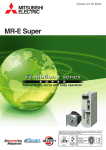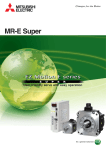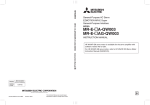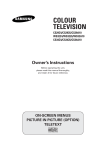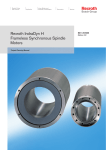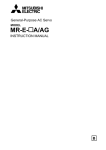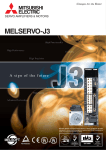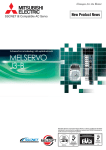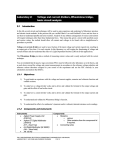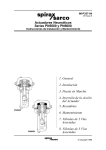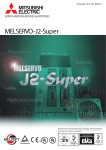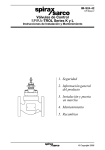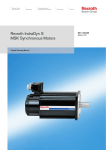Download Mitsubishi GENERAL PURPOSE AC SERVO MR-E- A/AG Specifications
Transcript
SERVO AMPLIFIERS & MOTORS MR-E User-friendly servo with easy operation Mitsubishi Electric Corporation Nagoya Works is a factory certified for ISO14001 (standards for environmental management systems) and ISO9001(standards for quality assurance management systems) EC97J1113 Competent footwork Enhancing 1 created by high performance and easy operations the system cost performance 1. High Performance ●Integrating the MR-J2-Super’s high performance High response is realized. High-accuracy positioning is possible. ● Gain settings can be performed easily by the advanced real-time auto-tuning function. ● Vibration can be suppressed by the adaptive vibration control function. ● Optimum tuning is possible with a personal computer and the setup software. ● 2 types of the pulse train interface (position control or speed control operation) and the analog input interface (speed control or torque control operation) are provided. ● ● 2. Easy To Use ●Easy operation Connectors have been installed on the fore part of the servo amplifier, thereby connecting the cables easily. ● Connectors have been adapted for the servo amplifier terminal block, thereby reducing the time required for wiring. ● The MR-E series is compatible with the MR-J2-Super series for setting. ● 3. Global Standard Products ●Compatible with global standards ● The MR-E standard specifications conform to EN, UL and cUL standards. 2 Applications Extensive applications Processing machines or machine tool feed Z Food processing machines, packing machines or feeders X Y Grinding machines Transfer machines Loaders/unloaders Wood working machines Dedicated machines Various positioning can be completed easily with pulse trains. Pillow packing machines Filling machines Label printing, label attaching machines Bag manufacturing machines Press feeders Roll feeders For various applications, Mitsubishi AC servo MR-E Series Textile machines The IP65 compatible motor can be used safely for food processing applications. Enhancing machine performance General-purpose inverter General-purpose motor Stepping motor Weaving machines Embroidery machines Knitting machines Winding machines Stranding machines Paper manufacturing machines 3 High-speed and high-accuracy applications are possible, enabling easy replacement with conventional devices. Replacement of inverters, stepping motors or DC servos Replacement from clutch, mechanical structure systems or hydraulic/air cylinders By using the servo as an alternative to legacy products, higher quality can be achieved. Servo Motor Features/Model Configurations Servo Motor Series Medium capacity series Small capacity series Motor series With Global standards Rated speed Rated output electro(maximum speed) Protection magnetic UL level EN (kW) brake cUL (r/min) (B) Feature ●HF-KE series ● Belt IP65 IP55 3000 (4500) ● Mounters 4 types 0.1, 0.2, 0.4, 0.75 Excluding the shaftthrough portion and connector ● Sewing Stable control from low speeds to high speeds allows compliance with a variety of applications. IP65 2000 (3000) drive ● Robots ●HF-SE series Note: A Application examples 4 types 0.5, 1.0, 1.5, 2.0 Excluding the shaftthrough portion machines tables ● Food processing machines ● X-Y ● Conveyor machines ● Robots ● X-Y tables mark shows production range. Model Configurations ■For servo amplifier MR-E- 10 A Mitsubishi general-purpose AC servo amplifier MR-E Series ● Conforms to following standards: EN, UL and cUL A : Pulse train interface AG : Analog input interface List of compatible motors Symbol 10 20 40 70 100 200 HF-KE 13 23 43 73 — — HF-SE — — — 52 102 152, 202 Note: There are some motors that cannot be connected depending on the amplifier’s software version. Refer to the servo motor specifications in this catalog. ■For servo motor 1 3 B HF-KE Symbol Rated output (kW) Symbol Motor series HF-KE Low inertia, small capacity HF-SE Medium inertia, medium capacity 1 to 7 0.1 to 0.75 10 to 20 1.0 to 2.0 Symbol Rated speed (r/min) 2 2000 (Note 1) 3 3000 (Note 2) Notes: 1. 2000r/min is only for HF-SE series. 2. 3000r/min is only for HF-KE series. ● Conforms to following standards: EN, UL and cUL Symbol None B Electromagnetic brake None Installed Note: Refer to “Electromagnetic brake specifications” in this catalog for the compatible models and detailed specifications. Symbol None Shaft end Standard (Straight shaft) K Key way or with key (Note) D-cut (Note) D Note: Refer to “Special shaft end specifications” in this catalog for the compatible models and detailed specifications. 4 Motor Specifications and Characteristics HF-KE series servo motor specifications Servo motor series HF-KE series (Low inertia, small capacity) Models Servo motor model Specifications Servo amplifier model HF-KE13 (B) HF-KE23 (B) HF-KE43 (B) HF-KE73 (B) MR-E-10A/AG (Note 9) MR-E-20A/AG (Note 9) MR-E-40A/AG (Note 9) MR-E-70A/AG (Note 9) Power facility capacity (Note 2) (kVA) Continuous Rated output (W) running Rated torque (N·m [oz·in]) duty 0.3 0.5 0.9 1.3 100 200 400 750 0.32 (45.3) 0.64 (90.6) 1.3 (184) 2.4 (340) Maximum torque (N·m [oz·in]) 0.95 (135) 1.9 (269) 3.8 (538) 7.2 (1020) 39.9 Rated speed (r/min) 3000 Maximum speed (r/min) 4500 Permissible instantaneous speed (r/min) 11.5 16.9 38.6 Rated current (A) 0.8 1.4 2.7 5.2 Maximum current (A) 2.4 4.2 8.1 15.6 (Note 5) (Note 5) 249 140 (Note 5) (Note 5) 747 210 — (Note 5) 2490 700 — — — With no options Regenerative braking frequency MR-RB032 (30W) (times/min) MR-RB12 (100W) (Note 3, 4) MR-RB32 (300W) Moment of inertia Standard J (×10-4kg·m2) With electromagnetic brake [J (oz·in2)] Servo motor 5175 Power rate at continuous rated torque (kW/s) 0.088 (0.481) 0.24 (1.31) 0.42 (2.30) 2100 1.43 (7.82) 0.090 (0.492) 0.31 (1.70) 0.50 (2.73) 1.63 (8.91) 15 times the servo motor’s inertia moment maximum (Note 6) Recommended load/motor inertia moment ratio Incremental encoder (resolution per servo motor rotation: 16384 p/rev) Speed/position detector Attachments — Totally enclosed non ventilated (protection level: IP55) (Note 1, 7) Structure 0 to 40°C (32 to 104°F) (non freezing), storage: −15 to 70°C (5 to 158°F) (non freezing) Ambient temperature Ambient humidity Environment 80% RH maximum (non condensing), storage: 90% RH maximum (non condensing) Atmosphere Indoors (no direct sunlight); no corrosive gas, inflammable gas, oil mist or dust 1000m or less above sea level; X: 49m/s2 Y: 49m/s2 Elevation/vibration (Note 8) Mass (kg [lb]) Standard 0.56 (1.3) 0.94 (2.1) 1.5 (3.4) 2.9 (6.4) With electromagnetic brake 0.86 (1.9) 1.6 (3.6) 2.1 (4.7) 3.9 (8.6) Notes:1. If used in location such as actual site of machinery where oil or water may contact the product, special specifications apply, so contact Mitsubishi. 2. The power facility capacity varies depending on the power supply’s impedance. 3. The regenerative braking frequency shows the permissible frequency for decelerating the motor without a load from the rated speed to a stop. When a load is connected, however, the value becomes the table value divided by (m+1) where m is the load inertia moment divided by the motor inertia moment. When the operating speed exceeds the rated speed, the regenerative braking frequency is inversely proportional to the square of (Operating speed/rated speed). When the operating speed varies frequently or when regeneration is constant (as with vertical feeds), find the regeneration heat generated (W) while operating. The heat should not exceed the tolerable regenerative power (W). Refer to the section “Options ●Optional regeneration unit” in this catalog for details on the tolerable regenerative power (W). 4. The regenerative braking frequency of the 600W and smaller servo amplifier may fluctuate due to the affect of the power voltage since the energy charged by the electrolytic capacitor in the servo amplifier is large. 5. There are no limits on regeneration frequency as long as the effective torque is within the rated torque range. However, the load/motor of inertia moment ratio must be 15 times or less. 6. Contact Mitsubishi if the load/motor of inertia moment ratio exceeds the value in the table. 7. The shaft-through portion and connector for cable terminal are excluded. 8. The vibration direction is shown in the right-side diagram. The numeric value indicates the maximum value of the component (commonly the bracket in the opposite X Y direction of the motor shaft). Fretting of the bearing occurs easily when the motor stops, so maintain vibration to approximately one-half of the allowable value. 9. The servo amplifier software is compatible with the HF-KE Series from version A5 or above. HF-KE series servo motor torque characteristics HF-KE23 (B) (Note 1, 2) 70 0.5 35 0.25 210 Peak running range 1.5 140 1.0 70 0.5 Continuous running range Continuous running range 0 0 1000 2000 3000 4000 4500 0 4.0 560 Torque (oz•in) Peak running range 0.75 Torque (N•m) Torque (oz•in) Torque (N•m) Torque (oz•in) 105 HF-KE43 (B) (Note 1, 2) 2.0 280 1.0 0 1000 2000 3000 4000 4500 420 Torque (N•m) HF-KE13 (B) (Note 1, 2) 140 Peak running range 3.0 280 2.0 140 1.0 0 Continuous running range 0 Speed (r/min) Speed (r/min) 1000 2000 3000 4000 4500 Speed (r/min) HF-KE73 (B) (Note 1, 2) 840 Torque (N•m) Torque (oz•in) 1120 8.0 Peak running range 6.0 560 4.0 280 2.0 Notes: 1. 2. Continuous running range 5 0 0 1000 2000 3000 Speed (r/min) 4000 4500 : For 3-phase 200VAC. : For 1-phase 230VAC. Motor Specifications and Characteristics HF-SE series servo motor specifications Servo motor series Models Servo motor model HF-SE series (Medium inertia, medium capacity) HF-SE52 (B) HF-SE102 (B) MR-E-70A/AG (Note 7) MR-E-100A/AG (Note 7) Power facility capacity (Note 1) (kVA) 1.0 1.7 2.5 Continuous running duty 0.5 1.0 1.5 2.0 2.39 (338) 4.77 (675) 7.16 (1010) 9.55 (1350) 7.16 (1010) 14.3 (2020) 21.5 (3040) 28.6 (4050) Specifications Servo amplifier model Rated output (kW) Rated torque (N·m [oz·in]) Maximum torque (N·m [oz·in]) HF-SE152 (B) Rated speed (r/min) 2000 Maximum speed (r/min) 3000 Servo motor Permissible instantaneous speed (r/min) HF-SE202 (B) MR-E-200A/AG (Note 7) 3.5 3450 Power rate at continuous rated torque (kW/s) 9.34 19.2 28.8 23.8 Rated current (A) 2.9 5.3 8.0 10 Maximum current (A) 8.7 15.9 24 30 With no options 120 62 MR-RB032 (30W) 180 93 152 — 71 — 600 — 310 — 1800 — 930 — Standard 6.1 (33.4) With electromagnetic brake 8.3 (45.4) Regenerative braking frequency MR-RB12 (100W) (times/min) MR-RB30 (300W) (Note 2, 3) MR-RB32 (300W) MR-RB50 (500W) Moment of inertia J (×10-4kg·m2) [J (oz·in2)] — — 456 — 213 — 11.9 (65.1) 760 17.8 (97.3) 355 38.3 (209) 14.0 (76.5) 20.0 (109) 47.9 (262) Recommended load/motor inertia moment ratio 15 times the servo motor’s inertia moment maximum (Note 4) Speed/position detector Incremental encoder (resolution per servo motor: 16384 p/rev) — Attachments Totally enclosed non ventilated (protection level: IP65) (Note 5) Structure 0 to 40°C (32 to 104°F) (non freezing), storage: −15 to 70°C (5 to 158°F) (non freezing) Ambient temperature 80% RH maximum (non condensing), storage: 90% RH maximum (non condensing) Ambient humidity Atmosphere Environment Indoors (no direct sunlight); no corrosive gas, inflammable gas, oil mist or dust 1000m or less above sea level Elevation Vibration (Note 6) Standard Mass (kg [lb]) X : 24.5m/s2 Y : 49m/s2 X,Y : 24.5m/s2 4.8 (11) 6.7 (15) With electromagnetic brake 6.5 (15) 8.5 (19) 8.3 (19) 11 (25) 12 (27) 18 (40) Notes:1. The power facility capacity varies depending on the power supply’s impedance. 2. The regenerative braking frequency shows the permissible frequency for decelerating the motor without a load from the rated speed to a stop. When a load is connected, however, the value becomes the table value divided by (m+1) where m is the load inertia moment divided by the motor inertia moment. When the operating speed exceeds the rated speed, the regenerative braking frequency is inversely proportional to the square of (Operating speed/rated speed). When the operating speed varies with the frequency or when regeneration is constant (as with vertical feeds), find the regeneration heat generated (W) while operating. The heat should not exceed the tolerable regenerative power (W). Refer to the section “Options ●Optional regeneration unit” in this catalog for details on the tolerable regenerative power (W). 3. The regenerative braking frequency of the 600W and smaller servo amplifier may fluctuate due to the affect of the power voltage since the energy charged by the electrolytic capacitor in the servo amplifier is large. 4. Contact Mitsubishi if the load/motor of inertia moment ratio exceeds the value in the table. 5. The shaft-through portion is excluded. 6. The vibration direction is shown in the right-side diagram. The numeric value indicates the maximum value of the component (commonly the bracket in the opposite direction of the motor shaft). Fretting of the bearing occurs easily when the motor stops, so maintain vibration to approximately one-half of the allowable value. 7. The servo amplifier software is compatible with the HF-SE Series from version A5 or above. X Y HF-SE series servo motor torque characteristics 420 700 3 5 1120 0 1000 2000 Speed (r/min) Peak running range 16 8 3000 0 0 1000 2000 Speed (r/min) 2800 1400 Continuous running range Continuous running range 0 2240 Torque (oz•in) 10 4200 24 Torque (N•m) 1400 Torque (oz•in) Peak running range 6 Peak running range HF-SE202 (B) (Note 1) HF-SE152 (B) (Note 1) 3360 15 Torque (N•m) Torque (oz•in) Torque (N•m) Torque (oz•in) 840 2100 9 3000 0 1000 2000 Peak running range 20 10 Continuous running range Continuous running range 0 30 Torque (N•m) HF-SE102 (B) (Note 1) HF-SE52 (B) (Note 1, 2) 1260 3000 0 0 1000 2000 3000 Speed (r/min) Speed (r/min) Notes: 1. 2. : For 3-phase 200VAC. : For 1-phase 230VAC. 6 Motor Dimensions ●HF-KE13(B) (Unit: mm) 2-ø4.5 mounting hole Use hexagonal cap head bolts. 20.5 96.4(137.5) 20.7 1 2.5 3 2 M40 25 5 Standard 4 A 45° with Brake Power supply 6 38.8 (Note 3) ø30h7 ø4 37.1 28.5 21 ø8h6 20.7 21.5 (Note 3) 7.2 1 4 2 5 3 6 A 18.4 (Note 3) 25.2 72.3(Note 3) 19.2 Power supply lead 13.9 0.3m 27.5 40.5 Power supply connector pin assignment Pin No. Signal name 1 U phase 2 V phase 3 W phase 4 Earth 6.4 connector pin assignment Pin No. Signal name 1 U phase 2 V phase 3 W phase 4 Earth 5 B1 6 B2 Protective tubing Brake lead (Note 3) 0.3m Power supply connector (made by Molex) 5557-04R-210 (receptacle) in standard case 5557-06R-210 (receptacle) (Note 3) 5556PBT (female terminal) A 13° 7° Encoder cable 0.3m With 1-172169-9 connector (made by AMP) Insulok (Note 3) Standard ●HF-KE23(B), HF-KE43(B) 4-ø5.8 mounting hole Use hexagonal cap head bolts. L 1 3 ø14h6 45° with Brake Power supply Power supply lead 0.3m 25.2 19.2 KL 71.8 (Note 3) 2 5 3 6 A connector pin assignment Pin No. Signal name 1 U phase V phase 2 3 W phase 4 Earth 5 B1 6 B2 Model 5.9 L KL HF-KE23 (B) 90.6 (130.1) 39.3 HF-KE43 (B) 112.5 (152) 61.2 27.8 Power supply connector (made by Molex) 5557-04R-210 (receptacle) in standard case 5557-06R-210 (receptacle) (Note 3) 5556PBT (female terminal) 13.5° 7° A 4 Variable dimensions 13.9 Protective tubing Insulok (Note 3) Brake lead (Note 3) 0.3m Encoder cable 0.3m With 1-172169-9 connector (made by AMP) 1 47.1 (Note 3) 47.1 37.5 ø50h7 ø7 0 (Note 3) 7.2 4 A M60 30 7 3 2 Power supply connector pin assignment Pin No. Signal name U phase 1 V phase 2 W phase 3 4 Earth ●HF-KE73(B) 127.8(171) M80 40 8 4-ø6.6 mounting hole Use hexagonal cap head bolts. 3 45° Standard 1 3 2 4 A 7.2 (Note 3) 25.2 79.5 (Note 3) Power supply lead 0.3m 19.2 72.3 Protective tubing 27.8 Power supply connector (made by Molex) 5557-04R-210 (receptacle) in standard case 5557-06R-210 (receptacle) (Note 3) 5556PBT (female terminal) A 7° 7° Encoder cable 0.3m With 1-172169-9 connector (made by AMP) 14 12 Insulok (Note 3) Brake lead (Note 3) 0.3m Notes: 1. Use a friction coupling to fasten a load. 2. Dimensions inside ( ) are for the models with electromagnetic brake. 3. Only for the models with electromagnetic brake. The electromagnetic brake terminals (B1, B2) do not have the polarity. 4. For dimensions where there is no tolerance listed, use general tolerance. 7 0 56.4 (Note 3) 57.1 47.5 ø19h6 ø70h7 ø9 with Brake 1 4 2 5 3 6 A Power supply connector pin assignment Pin No. 1 2 3 4 Signal name U phase V phase W phase Earth Power supply connector pin assignment Pin No. Signal name 1 U phase 2 V phase 3 W phase 4 Earth 5 B1 6 B2 Motor Dimensions ●HF-SE52(B), HF-SE102(B), HF-SE152(B) (Unit: mm) 4-ø9 mounting hole Use hexagonal cap head bolts. L 39.7(45) 55 50 12 M130 45° 3 (Note 3) ø1 ø1 65 112.5 (Note 3) ø110h7 (Note 3) 81.5 79.9(Note 3) (Note 3) 45 ø24h6 (Note 3) 19.5 (Note 3) (Note 3) 60.5(Note 3) 20.9 Encoder connector MS3102A20-29P 13.5 KL Brake connector CM10-R2P (Note 3) Power supply connector MS3102A18-10P 58 Earth Brake 29 (Note 3) W C B D A V U Power supply connector pin assignment Motor flange direction Brake connector pin assignment Motor flange direction (Note 3) Variable dimensions Model L KL HF-SE52 (B) 120 (154.5) 57.8 HF-SE102 (B) 142 (176.5) 79.8 HF-SE152 (B) 164 (198.5) 101.8 ●HF-SE202(B) 4-ø13.5 mounting hole Use hexagonal cap head bolts. 145(194.5) ø2 30 00 ø2 140.9 96.9(Note 3) 81.5 (Note 3) 45° 75 0 ø114.3 -0.025 3 ø35 +0.010 0 (Note 3) (Note 3) M176 79 18 40(47) 19.5 (Note 3) 44 (Note 3) 68(Note 3) Encoder connector MS3102A20-29P Brake connector CM10-R2P (Note 3) Power supply connector MS3102A22-22P (Note 3) 24.8 79.8 82 Brake W Earth C B Brake connector pin assignment Motor flange direction (Note 3) D A U V Power supply connector pin assignment Motor flange direction Notes: 1. Use a friction coupling to fasten a load. 2. Dimensions inside ( ) are for the models with electromagnetic brake. 3. Only for the models with electromagnetic brake. The electromagnetic brake terminals do not have the polarity. 4. For dimensions where there is no tolerance listed, use general tolerance. 8 Motor Special Specifications Special shaft end specifications Motors with the following specifications are available. HF-KE series ● With key (200, 400, 750W) R Q Variable dimensions S R Q W QK QL U Y QK 200, 400 5 14h6 30 27 5 20 3 3 M4 screw Depth: 15mm 750 6 19h6 40 37 6 25 5 3.5 M5 screw Depth: 20mm HF-KEMK QL U A øS T W Capacity (W) Motor model (Note 1) Y T A A-A (Unit: mm) ● D-cut (100W) 25 (Note 1) 21.5 1 20.5 ø8h6 (Unit: mm) HF-SE series ● Key way R Q Variable dimensions S R Q W QK QL U r Y 0.5 to 1.5 24h6 55 50 8 0 -0.036 36 5 4 +0.2 0 4 M8 screw Depth: 20mm 35 + 0.01 0 79 75 10 0 -0.036 55 5 5 + 0.2 0 5 M8 screw Depth: 20mm HF-SEMK 2.0 QK U QL A øS Capacity (kW) W Motor model (Note 1, 2) A r Y A-A (Unit: mm) Notes: 1. Cannot be used in applications that involve high frequency. Loose keys may damage the motor shaft. 2. A key is not installed. The key shall be installed by the user. Electromagnetic brake specifications HF-KE series Motor model 13B Type 23B Brake life (Note 1) (Braking work per braking action) 102B 152B 202B Spring-action safety brake 0 0 24VDC-10% (N·m) 0.32 1.3 1.3 2.4 8.5 8.5 8.5 44 (oz·in) 45.3 184 184 340 1200 1200 1200 6230 6.3 7.9 7.9 10 20 20 20 34 (J)/time 5.6 22 22 64 400 400 400 4500 (J)/hour 56 220 220 640 4000 4000 4000 45000 20000 (5.6J) 20000 (22J) 20000 (22J) 20000 (64J) 20000 (200J) 20000 (200J) 20000 (200J) 20000 (1000J) Times Notes: 1. The brake gap cannot be adjusted. The brake life shows the time until the readjustment is needed. 2. The electromagnetic brake is for holding. It cannot be used for braking applications. 9 52B 24VDC-10% Power consumption (W) at 20°C (68°F) Permissible braking work 73B Spring-action safety brake Rated voltage Brake static friction torque HF-SE series 43B Peripheral Equipment (standard interface) Connections with peripheral equipment Peripheral equipment is connected to MR-E as described below. Connectors, options, and other necessary equipment are available so that users can set up MR-E easily and begin using it right away. Power supply 3-phase 200-230VAC or 1-phase 230VAC CN3 for RS-232C communication (option) Display panel Displays monitoring data, parameters, and alarms. Circuit breaker (NFB) Connect the unit to user’s personal computer to perform monitoring, batch parameter entry and saving, graph display, and test operation. Dedicated cable and setup software are also available. Setting section Parameter settings and monitoring etc. are executed with push buttons. Used to protect the power supply line. Servo amplifier MR-E- A/AG Magnetic contactor (MC) CN3 Used to turn off the servo amplifier’s power when an alarm has been triggered. Positioning controllers The MR-E can be connected to a Mitsubishi controller or any pulse train output controller. CN1 R S Control signal connector T Power factor improvement reactor (FR-BAL) CN2 X Y FX 2N-10GM FX 2N-1PG QD75P QD75D FX 2N-20GM FX 2N-10PG P1,2,4 D1,2,4 A1SD75P P1 to 3 Z Control signal (for operation panel) Connected to the PLC’s I/O port or the machine’s operation panel. Charge lamp CNP2 Illuminates when the main circuit power supply is ON. Do not plug/unplug power lines when this lamp is ON. CNP1 L3 L2 L1 Optional regeneration unit (option) C Install this unit in situations involving frequent regeneration and large load inertia moments. Connect this unit referring to “Standard Wiring Diagram”. P Note: 1. When using a 1-phase 230VAC power supply, connect the power supply to the L1 and L2 terminals. Do not connect anything to L3. HF- E servo motor (Above picture is HF-KE73.) 10 Amplifier Specifications MR-E-A Servo amplifier model MR-E- 10A Voltage/frequency (Note 1) Power supply Permissible voltage fluctuation 20A 40A 70A 3-phase 200 to 230VAC: 3-phase170 to 253VAC 1-phase 230VAC: 1-phase207 to 253VAC 3-phase 170 to 253VAC ±5% maximum Permissible frequency fluctuation Sine-wave PWM control/current control system Dynamic brake Safety features Built-in None None Installed Installed Installed Installed Overcurrent shutdown, regeneration overvoltage shutdown, overload shutdown (electronic thermal), encoder fault protection, regeneration fault protection, undervoltage/sudden power outage protection, overspeed protection, excess error protection 500kpps (when using differential receiver), 200 kpps (when using open collector) Servo amplifier Maximum input pulse frequency Position control mode Positioning feedback pulse Resolution per encoder/servo motor rotation: 16384 p/rev Command pulse multiple Electronic gear A/B multiple, A: 1 to 65535, B: 1 to 65535 1/50 < A/B < 50 Positioning complete width setting 0 to ±16384 pulses (command pulse unit) ±2.5 rotations Excess error Set by parameters Torque limit Speed control range Speed control mode Internal speed command 1:5000 ±0.01% maximum (load fluctuation 0 to 100%) 0% (power fluctuation ±10%) Speed fluctuation rate Set by parameters Torque limit Self-cooling open (IP00) Structure 90% RH maximum (non condensing), storage: 90% RH maximum (non condensing) Ambient humidity Indoors (no direct sunlight); no corrosive gas, inflammable gas, oil mist or dust Atmosphere 1000m or less above sea level Elevation 5.9m/s2 maximum Vibration Mass (kg [lb]) Fan cooling open (IP00) 0 to 55°C (32 to 131°F) (non freezing), storage: –20 to 65°C (–4 to 149°F) (non freezing) Ambient temperature Environment 200A 3-phase 200 to 230VAC 50/60Hz (Note 2) Control system Built-in regenerative resistor 100A 3-phase 200 to 230VAC 50/60Hz or 1-phase 230VAC 50/60Hz (Note 2) 0.7 (1.6) 0.7 (1.6) 1.1 (2.5) 1.7 (3.8) 1.7 (3.8) 2.0 (4.4) 10AG 20AG 40AG 70AG 100AG 200AG MR-E-AG Servo amplifier model MR-E- Power supply Voltage/frequency (Note 1) 3-phase 200 to 230VAC 50/60Hz or 1-phase 230VAC 50/60Hz (Note 2) 3-phase 200 to 230VAC 50/60Hz (Note 2) Permissible voltage fluctuation 3-phase 200 to 230VAC: 170 to 253VAC 1-phase 230VAC: 207 to 253VAC 3-phase 170 to 253VAC ±5% maximum Permissible frequency fluctuation Sine-wave PWM control/current control system Control system Built-in Dynamic brake Built-in regenerative resistor Servo amplifier Safety features None None Installed Installed Installed Installed Overcurrent shutdown, regeneration overvoltage shutdown, overload shutdown (electronic thermal), encoder fault protection, regeneration fault protection, undervoltage/sudden power outage protection, overspeed protection, excess error protection Analog speed command 1:2000, internal speed command 1:5000 Speed control range 0 to ±10VDC/rated speed Analog speed command input Speed control mode Speed fluctuation rate ±0.01% maximum (load fluctuation 0 to 100%) 0% (power fluctuation ±10%) ±0.2% maximum (ambient temperature 25°C±10°C [77°F±50°F]), when using analog speed command Set by parameters or external analog input (0 to +10VDC/maximum torque) Torque limit Torque control mode 0 to ±8VDC/maximum torque (input impedance 10 to 12kΩ) Analog torque command input Set by parameters or external analog input (0 to ±10VDC/rated speed) Speed limit Self-cooling open (IP00) Structure 90% RH maximum (non condensing), storage: 90% RH maximum (non condensing) Ambient humidity Environment Indoors (no direct sunlight); no corrosive gas, inflammable gas, oil mist or dust Atmosphere 1000m or less above sea level Elevation 5.9m/s2 maximum Vibration Mass 11 (kg [lb]) Fan cooling open (IP00) 0 to 55°C (32 to 131°F) (non freezing), storage: –20 to 65°C (–4 to 149°F) (non freezing) Ambient temperature 0.7 (1.6) 0.7 (1.6) 1.1 (2.5) 1.7 (3.8) 1.7 (3.8) 2.0 (4.4) Notes: 1. Rated output and rated speed of the servo motor used in combination with the servo amplifier are as indicated when using the power supply voltage and frequency listed. The torque drops when the power supply voltage is less than specified. 2. When the power supply is 3-phase 200VAC or 1-phase 230VAC, the mentioned torque characteristics in which the servo amplifier is combined with a servo motor is applied. Standard Wiring Diagram MR-E-A type: Position control operation ●Connection to QD75D (position servo, incremental) Create a sequence that cuts off the MC when an alarm or emergency stop occurs. NFB MC Power supply 3-phase 200 to 230VAC or 1-phase 230VAC (Note 12) Servo amplifier MR-E-MA CNP 1 CNP 2 U L1 L2 L3 Servo motor HF-KE series U 1 V 2 W V W 4 The servo amplifier could be damaged if the optional regeneration unit is incorrectly connected. B1 P C Optional regeneration unit D (Note 2) EMG 5 6 (Note 7) Shut off when the servo on signal turns off and when alarm signal is issued. Built-in regenerative resistor PULSE F– PULSE R+ PULSE R– CLEAR MM16 MM17 MM18 MM13 MM14 PG NP NG MM11 MM12 RD PG05 MM 9 PG0 COM MM10 LZ LZR LG PP CR SG 23 22 25 P5 7 P5 7 P5 2 LG 8 LG 8 LG 3 MR 1 MR 1 MR 4 MRR 2 MRR 2 MRR 7 MD 4 MD 4 MD 8 MDR 5 MDR 5 MDR 9 — 3 3 24 5 13 11 19 20 14 Encoder A-phase pulse (differential line driver) LA LAR 15 16 Encoder B-phase pulse (differential line driver) Control common LB LBR 17 18 Control common Encoder Z-phase pulse (open collector) (Note 11) 1 LG 14 OP 21 SD PLATE 2m maximum for open collector. 10m maximum for differential line driver. 10 LG PLATE SD EMG 8 Servo on Reset (Note 4) Forward stroke end Reverse stroke end SON 4 RES 3 LSP 6 LSN 7 SG 13 10m maximum 1 OPC 2 ALM 9 (Note 6) Malfunction RA1 Zero speed detection RA2 ZSP 12 In position RA3 INP 10 10m maximum 9 SD 6 CNT 6 CNT Servo motor CN3 2 TXD 1 RXD 3 LG RS-232C RD GND SD GND Personal computer running Microsoft Windows HF-SE series U A V B SM W C D U V W (Note 10) B1 24VDC B2 EMG Shut off when the servo on signal turns off and when alarm signal is issued. Monitor output Maximum +1mA total Double oscillation (±10V output) (Note 13) 4 MO1 A 6 MO2 A 3 LG PLATE SD Monitor output 1 (Note 7) Electromagnetic brake 10kΩ Monitor output 2 10kΩ 2m maximum VIN — 9 SD 15m maximum (Note 3) Emergency stop (Note 1) — Encoder CN2 CN1 Pin No. MM15 (Note 9) Control common External 24VDC power supply (0.2A or more) B2 Disconnect P and D when connecting the optional regeneration unit externally. (Note 5) Name PULSE F+ CLEAR COM READY RDY COM Power supply 24VDC for the electromagnetic brake Electromagnetic brake CN2 1 P5 (Note 11) 2 LG S R 3 MR C 4 MRR D 7 MD A 8 MDR B 9 F G — 10 LG PLATE SD Encoder Positioning unit QD75D Connect P and D when using the built-in regenerative resistor. SM 3 N M Notes: 1. Do not reverse the diode’s direction. Connecting it backwards could cause the servo amplifier to malfunction that signals are not output, and emergency stop and other safety circuits are inoperable. 2. Provide a 24VDC ±10% 200mA power supply from an external source for the interface. 200mA is the value when all input/output signals are used. The current capacity can be stepped down according to the number of input/output points in use. 3. EMG (emergency stop) contact (normally closed contact) must be installed. If it is not installed, operation will be impossible. 4. LSP and LSN contacts must be closed for normal operation. If they are not closed, the commands will not be accepted. 5. Signals with the same name are connected inside. 6. Malfunction signal (ALM) is turned on during normal operation when no alarms have been triggered. 7. For the motor with an electromagnetic brake. The electromagnetic brake terminals (B1, B2) do not have the polarity. 8. Connect the shield wire securely to the plate inside the connector (ground plate). 9. This connection is not necessary for QD75D of the positioning unit. Note that the connection between LG and control common terminal is recommended to increase noise resistance depending on the positioning unit being used. 10. Always use a shielded multicore cable up to a maximum of 15m in a low noise environment. However, if the RS-232C communication is set up with a baud rate of more than 38400bps, keep the cable length to within 3m. 11. Refer to “MR-E-A/AG INSTRUCTION MANUAL” for details. 12. When using a 1-phase 230VAC power supply, connect the power supply to the L1 and L2 terminals. Do not connect anything to L3. The 1-phase 230VAC power supply is available only for MR-E-70A or smaller servo amplifiers. 13. Use the analog monitor/RS-232C branch cable (MR-E3CBL15-P) when connecting the analog monitor output 1 (MO1), analog monitor output 2 (MO2) and a personal computer. 12 Standard Wiring Diagram MR-E-A type: Internal speed control operation ●Connection Create a sequence that cuts off the MC when an alarm or emergency stop occurs. NFB MC Power supply 3-phase 200 to 230VAC or 1-phase 230VAC (Note 11) Servo amplifier MR-E-MA CNP 1 L1 L2 L3 Servo motor HF-KE series CNP 2 U U 4 B1 CN1 PP Encoder Z-phase pulse (differential line driver) PG NP 23 22 25 NG 24 LZ LZR 19 20 15 16 LA LAR Encoder A-phase pulse (differential line driver) LB Encoder B-phase pulse (differential line driver) LBR Control common Control common LG OP SD Encoder Z-phase pulse (open collector) 17 18 Built-in regenerative resistor (Note 10) 1 P5 7 P5 7 P5 2 LG 8 LG 8 LG 3 MR 1 MR 1 MR 4 MRR 2 MRR 2 MRR 7 MD 4 MD 4 MD 8 MDR 5 MDR 5 MDR 9 10 3 — LG PLATE SD — 3 — 9 SD 9 SD 6 CNT 6 CNT Servo motor HF-SE series 21 PLATE CN3 2 2m maximum (Note 3) Emergency stop EMG 8 Servo on Forward rotation start Reverse rotation start (Note 4) Forward stroke end Reverse stroke end SON 4 ST1 3 ST2 5 LSP LSN 6 7 SG 13 10m maximum RxD 3 LG RD GND SD GND Personal computer running Microsoft Windows U V A W B C D U V W 24VDC B2 EMG 3 PLATE Monitor output Maximum +1mA total Double oscillation (±10V output) (Note 12) A MO1 Monitor output 1 10kΩ MO2 A Monitor output 2 LG 10kΩ SD (Note 7) Shut off when the Electromagnetic servo on signal turns brake off and when alarm signal is issued. CN2 (Note 10) 1 P5 S 2 LG Ready RA1 RD 3 MR R C (Note 6) Malfunction RA2 ALM 9 4 MRR D Zero speed detection Speed reached RA3 ZSP 12 7 MD RA4 SA 10 8 MDR A B (Note 1) 11 2m maximum — F 10 LG PLATE SD G N 9 10m maximum SM B1 (Note 9) 15m maximum 6 1 RS-232C TxD 1 4 VIN (Note 7) 14 10m maximum (Note 2) 6 Shut off when the servo on signal turns off and when alarm signal is issued. CN2 (Note 5) B2 EMG Encoder D Disconnect P and D when connecting the optional regeneration unit externally. Power supply 24VDC for the electromagnetic brake Electromagnetic brake 5 Encoder P C Optional regeneration unit External 24VDC power supply (0.2A or more) SM 3 The servo amplifier could be damaged if the optional regeneration unit is incorrectly connected. Connect P and D when using the built-in regenerative resistor. 1 V 2 W V W M 13 Notes: 1. Do not reverse the diode’s direction. Connecting it backwards could cause the servo amplifier to malfunction that signals are not output, and emergency stop and other safety circuits are inoperable. 2. Provide a 24VDC±10% 200mA power supply from an external source for the interface. 200mA is the value when all input/output signals are used. The current capacity can be stepped down according to the number of input/output points in use. 3. EMG (emergency stop) contact (normally closed contact) must be installed. If it is not installed, operation will be impossible. 4. LSP and LSN contacts must be closed for normal operation. If they are not closed, the commands will not be accepted. 5. Signals with the same name are connected inside. 6. Malfunction signal (ALM) is turned on during normal operation when no alarms have been triggered. 7. For the motor with an electromagnetic brake. The electromagnetic brake terminals (B1, B2) do not have the polarity. 8. Connect the shield wire securely to the plate inside the connector (ground plate). 9. Always use a shielded multicore cable up to a maximum of 15m in a low noise environment. However, if the RS-232C communication is set up with a baud rate of more than 38400bps, keep the cable length to within 3m. 10. Refer to “MR-E-A/AG INSTRUCTION MANUAL” for details. 11. When using a 1-phase 230VAC power supply, connect the power supply to the L1 and L2 terminals. Do not connect anything to L3. The 1-phase 230VAC power supply is available only for MR-E-70A or smaller servo amplifiers. 12. Use the analog monitor/RS-232C branch cable (MR-E3CBL15-P) when connecting the analog monitor output 1 (MO1), analog monitor output 2 (MO2) and a personal computer. Standard Wiring Diagram MR-E-AG type: Speed control operation ●Connection Create a sequence that cuts off the MC when an alarm or emergency stop occurs. NFB MC Power supply 3-phase 200 to 230VAC or 1-phase 230VAC (Note 11) Servo amplifier MR-E-MAG CNP 1 L1 L2 L3 Servo motor HF-KE series CNP 2 U U 4 B1 B2 CN2 (Note 5) LA LAR 19 20 15 16 LB LBR 17 18 LZ LZR Encoder Z-phase pulse (differential line driver) Encoder A-phase pulse (differential line driver) Encoder B-phase pulse (differential line driver) Control common Control common LG OP Encoder Z-phase pulse (open collector) SD 14 21 PLATE 2m maximum 10m maximum EMG 8 Servo on Forward rotation start Reverse rotation start (Note 4) Forward stroke end Reverse stroke end SON 4 ST1 3 ST2 5 LSP LSN 6 7 SG 13 10m maximum (Note 2) P5 7 P5 7 P5 2 LG 8 LG 8 LG 3 MR 1 MR 1 MR 4 MRR 2 MRR 2 MRR 7 MD 4 MD 4 MD 8 MDR 5 MDR 5 MDR 9 — 10 LG RA1 Upper limit setting — 3 VIN 1 RD 11 RA2 ALM 9 RA3 ZSP RA4 SA 12 10 CN3 2 RS-232C RD GND SD GND TxD 1 RxD 3 LG 9 SD 6 CNT 6 CNT Personal computer running Microsoft Windows 26 LG 14 Upper limit setting U V A W B C D U V W 4 MO2 3 LG TLA SD 2 PLATE (Note 7) 10kΩ A CN2 Monitor output 2 10kΩ SD 2m maximum (Note 10) 1 P5 S 2 LG 3 MR R C 4 MRR D 7 MD A B 8 MDR Analog torque limit +10V/maximum torque B2 Shut off when the Electromagnetic servo on signal turns brake off and when alarm signal is issued. Monitor output Maximum +1mA total Double oscillation (±10V output) (Note 12) A MO1 Monitor output 1 6 SM B1 24VDC EMG PLATE VC — 9 SD (Note 9) 15m maximum 10m maximum Analog speed command ±10V/rated speed 3 Servo motor HF-SE series (Note 1) Ready (Note 6) Malfunction Zero speed detection Speed reached (Note 10) 1 PLATE SD (Note 3) Emergency stop (Note 7) Shut off when the servo on signal turns off and when alarm signal is issued. Built-in regenerative resistor Connect P and D when Disconnect P and D when using the built-in connecting the optional regenerative resistor. regeneration unit externally. CN1 6 EMG Encoder D Power supply 24VDC for the electromagnetic brake Electromagnetic brake 5 — F 10 LG PLATE SD G N 9 Encoder P C Optional regeneration unit External ±15VDC power supply SM 3 The servo amplifier could be damaged if the optional regeneration unit is incorrectly connected. External 24VDC power supply (0.2A or more) 1 V 2 W V W M 2m maximum Notes: 1. Do not reverse the diode’s direction. Connecting it backwards could cause the servo amplifier to malfunction that signals are not output, and emergency stop and other safety circuits are inoperable. 2. Provide a 24VDC±10% 200mA power supply from an external source for the interface. 200mA is the value when all input/output signals are used. The current capacity can be stepped down according to the number of input/output points in use. 3. EMG (emergency stop) contact (normally closed contact) must be installed. If it is not installed, operation will be impossible. 4. LSP and LSN contacts must be closed for normal operation. If they are not closed, the commands will not be accepted. 5. Signals with the same name are connected inside. 6. Malfunction signal (ALM) is turned on during normal operation when no alarms have been triggered. 7. For the motor with an electromagnetic brake. The electromagnetic brake terminals (B1, B2) do not have the polarity. 8. Connect the shield wire securely to the plate inside the connector (ground plate). 9. Always use a shielded multicore cable up to a maximum of 15m in a low noise environment. However, if the RS-232C communication is set up with a baud rate of more than 38400bps, keep the cable length to within 3m. 10. Refer to “MR-E-A/AG INSTRUCTION MANUAL” for details. 11. When using a 1-phase 230VAC power supply, connect the power supply to the L1 and L2 terminals. Do not connect anything to L3. The 1-phase 230VAC power supply is available only 14 for MR-E-70AG or smaller servo amplifiers. 12. Use the analog monitor/RS-232C branch cable (MR-E3CBL15-P) when connecting the analog monitor output 1 (MO1), analog monitor output 2 (MO2) and a personal computer. Standard Wiring Diagram MR-E-AG type: Torque control operation ●Connection Create a sequence that cuts off the MC when an alarm or emergency stop occurs. NFB MC Power supply 3-phase 200 to 230VAC or 1-phase 230VAC (Note 10) Servo amplifier MR-E-MAG CNP 1 L1 L2 L3 Servo motor HF-KE series CNP 2 U U 4 B1 P C Optional regeneration unit D Power supply 24VDC for the electromagnetic brake B2 Electromagnetic brake 5 6 (Note 6) EMG Shut off when the servo on signal turns off and when alarm signal is issued. Built-in regenerative resistor Disconnect P and D when connecting the optional regeneration unit externally. CN1 Encoder Z-phase pulse (differential line driver) LZ LZR Encoder A-phase pulse (differential line driver) LA LAR 19 20 15 16 LB LBR 17 18 Control common LG OP Encoder Z-phase pulse (open collector) SD 14 P5 7 P5 7 P5 2 LG 8 LG 8 LG 3 MR 1 MR 1 MR 4 MRR 2 MRR 2 MRR 7 MD 4 MD 4 MD 8 MDR 5 MDR 5 MDR 21 PLATE 2m maximum 10m maximum 9 — 10 LG PLATE SD (Note 3) Emergency stop EMG 8 Servo on Forward rotation select Reverse rotation select SON 4 RS1 5 RS2 3 SG 13 CN3 VIN 1 1 RxD 3 LG 11 Ready RA1 RD Malfunction Zero speed detection RA2 ALM 9 RA3 ZSP 12 10m maximum Analog torque command ±8V/rated speed TC 2 LG 14 Upper limit setting — 9 SD 9 SD 6 CNT 6 CNT RD GND SD GND Personal computer running Microsoft Windows 4 MO1 A 6 MO2 A 3 LG U V A W B C D U V W VLA SD 26 PLATE B2 EMG (Note 6) Shut off when the servo on signal turns Electromagnetic off and when alarm brake signal is issued. Monitor output 1 10kΩ CN2 Monitor output 2 10kΩ SD 2m maximum (Note 9) 1 P5 S 2 LG 3 MR R C 4 MRR D 7 MD A B 8 MDR Analog speed limit 0 to ±10V/maximum torque SM B1 24VDC Monitor output Maximum +1mA total Double oscillation (±10V output) (Note 11) PLATE Upper limit setting 3 (Note 8) 15m maximum (Note 1) (Note 5) RS-232C TxD 10m maximum (Note 2) — Servo motor HF-SE series 2 External 24VDC power supply (0.2A or more) 3 — F 10 LG PLATE SD G N 9 Encoder Encoder B-phase pulse (differential line driver) Control common (Note 9) 1 Encoder CN2 (Note 4) External ±15VDC power supply SM 3 The servo amplifier could be damaged if the optional regeneration unit is incorrectly connected. Connect P and D when using the built-in regenerative resistor. 1 V 2 W V W M 2m maximum 15 Notes: 1. Do not reverse the diode’s direction. Connecting it backwards could cause the servo amplifier to malfunction that signals are not output, and emergency stop and other safety circuits are inoperable. 2. Provide a 24VDC±10% 200mA power supply from an external source for the interface. 200mA is the value when all input/output signals are used. The current capacity can be stepped down according to the number of input/output points in use. 3. EMG (emergency stop) contact (normally closed contact) must be installed. If it is not installed, operation will be impossible. 4. Signals with the same name are connected inside. 5. Malfunction signal (ALM) is turned on during normal operation when no alarms have been triggered. 6. For the motor with an electromagnetic brake. The electromagnetic brake terminals (B1, B2) do not have the polarity. 7. Connect the shield wire securely to the plate inside the connector (ground plate). 8. Always use a shielded multicore cable up to a maximum of 15m in a low noise environment. However, if the RS-232C communication is set up with a baud rate of more than 38400bps, keep the cable length to within 3m. 9. Refer to “MR-E-A/AG INSTRUCTION MANUAL” for details. 10. When using a 1-phase 230VAC power supply, connect the power supply to the L1 and L2 terminals. Do not connect anything to L3. The 1-phase 230VAC power supply is available only for MR-E-70AG or smaller servo amplifier. 11. Use the analog monitor/RS-232C branch cable (MR-E3CBL15-P) when connecting the analog monitor output 1 (MO1), analog monitor output 2 (MO2) and a personal computer. Amplifier Dimensions ●MR-E-10A/AG, 20A/AG (Unit: mm) Approx. 70 50 135 Space required for heat radiation (40 minimum) 6 156 6 168 6 ø6 mounting hole Space required for heat radiation (40 minimum) 6 Three ground (PE) terminals (M4) Mounting screw size: M5 4 ●MR-E-40A/AG 70 22 135 156 6 168 Approx. 70 Space required for heat radiation (40 minimum) 6 ø6 mounting hole 6 Space required for heat radiation (40 minimum) Three ground (PE) terminals (M4) Mounting screw size: M5 4 16 Amplifier Dimensions ●MR-E-70A/AG, 100A/AG (Unit: mm) Approx. 70 190 70 22 25 Space required for heat radiation (40 minimum) 168 156 ø6 mounting hole 6 Space required for heat radiation (40 minimum) 22 42 6 6 Three ground (PE) terminals (M4) Mounting screw size: M5 ●MR-E-200A/AG Approx. 70 6 90 78 195 40 Space required for heat radiation (40 minimum) 168 156 6 ø6 mounting hole Fan (airflow direction) Three ground (PE) terminals (M4) Space required for heat radiation (40 minimum) Mounting screw size: M5 6 17 Options ● Optional regeneration unit Built-in regenerative resistor/tolerable regenerative power (W) MR-RB032 MR-RB12 MR-RB30 MR-RB32 MR-RB50 Resistance value (Ω) MR-E-10A/AG — 30 ✕ ✕ ✕ ✕ 40 MR-E-20A/AG — 30 100 ✕ ✕ ✕ 40 MR-E-40A/AG 10 30 100 ✕ ✕ ✕ 40 MR-E-70A/AG 20 30 100 ✕ 300 ✕ 40 MR-E-100A/AG 20 30 100 ✕ 300 ✕ 40 MR-E-200A/AG 100 ✕ ✕ 300 ✕ 500 13 Servo amplifier model Optional regeneration unit/tolerable regenerative power (W) Notes: 1. Connect the optional regeneration unit referring to “Standard Wiring Diagram”. 2. The tolerable regenerative power in the table differs from the regenerative resistor’s rated wattage. ● MR-RB032, MR-RB12 ● MR-RB30, MR-RB32 ø6 mounting hole 144 142 P G4 G3 C 8.5 5 168 156 125 (6) (12) 8.5 LB 150 LA 318 17 7 335 90 10 100 12 6 79 TE1 6 1.6 <Terminal arrangement> LD (20) Mounting screw size: M6 P LC <Terminal arrangement> TE1 Mounting screw size: M5 Variable dimensions LA LB LC LD Mass kg (lb) MR-RB032 30 15 119 99 0.5 (1.1) MR-RB12 40 15 169 149 1.1 (2.5) Model Model C Mass kg (lb) G3 MR-RB30 2.9 (6.4) G4 MR-RB32 2.9 (6.4) Terminal screw size: M4 G3 G4 P C Terminal screw size: M3 49 12.5 ● MR-RB50 (Note 4) 82.5 P 162.5 Wind blows in direction of arrow 200 217 17 <Terminal arrangement> 7 ✕ 14 long hole 12.5 133 2.3 G4 G3 C 350 82.5 162.5 Fan mounting screw 2-M3 screw provided on opposite side 7 12 Approx.30 108 120 Mounting screw size: M6 Model Mass kg (lb) MR-RB50 5.6 (13) P C G3 G4 Terminal screw size: M4 8 (Unit: mm) Notes: 1. The optional regeneration unit will heat up to approx. 100°C (212°F), so do not directly mount it on a wall susceptible to heat. Use nonflammable wires or provide flame resistant treatment (use silicon tubes, etc.), and wire so that the wires do not contact the optional regeneration unit. 2. Always use twisted wires for the optional regeneration unit, and keep the length as short as possible (5m or less). 3. Always use twisted wires for a thermal sensor, and make sure that the sensor does not fail to work properly due to inducted noise. 4. When using the MR-RB50, always forcibly cool with a cooling fan (approx. 1.0m3/min, M92). The cooling fan must be prepared by user. 18 Options ● Cables and connectors (for MR-E-MA/AG type) Optional cables and connectors are shown in the diagram below. QD75P QD75D Positioning unit Servo motor HF-SE series 10 Servo motor HF-KE series 7 A1SD75P CN3 CN1 FX2N-20GM 9 FX2N-10GM 5 6 8 FX2N-10PG CN2 FX2N-1PG CNP2 19 20 13 14 CNP1 11 12 23 Operation panel 1 15 16 17 18 Main power supply Item q Encoder cable for HF-KE series motor Model Protection level M=cable length 2, 5, 10, 20, 30, 40, 50m (Note 1) IP20 MR-EKCBLMM-L M=cable length 2, 5, 10, 20, 30m (Note 1) IP20 MR-ESCBLMM-H IP20 MR-ESCBLMM-L IP20 w M=cable length 2, 5, 10, 20, 30m (Note 1) 19 20 21 22 2 3 4 MR-EKCBLMM-H M=cable length 2, 5, 10, 20, 30, 40, 50m (Note 1) Cable attached to motor 0.3m Description Amplifier-side connector (made by Molex or an equivalent product) (Note 3) Junction connector (made by AMP) 1-172161-9 (black connector housing) 170359-1 (connector pin) Encoder MTI-0002 (cable clamp, made by TOA ELECTRIC INDUSTRIAL) Amplifier-side connector (made by Molex or an equivalent product) (Note 3) Encoder connector (made by DDK) MS3057-12A (cable clamp) MS3106B20-29S (straight plug) Encoder (Note 4) Select one for use with CN2 Encoder cable for HF-SE series motor Backshell (made by DDK) CE02-20BS-S MR-ENECBLMM-H M=cable length 2, 5, 10, 20, 30, 40, 50m (Note 1, 5) e IP65 IP67 Amplifier-side connector (made by Molex or an equivalent product) (Note 3) r Encoder connector set for HF-KE series motor MR-ECNM IP20 MR-ECNS IP20 Encoder connector set for HF-SE series motor For CN1 y u Amplifier-side connector (made by Molex or an equivalent product) (Note 3) Amplifier-side connector (made by Molex or an equivalent product) (Note 3) t Plug (made by DDK) MS3106A20-29S (D190) MR-ENECNS CN1 connector MR-ECN1 (20 pcs/box unit) Plug (made by DDK) MS3106A20-29S (D190) IP65 IP67 — Cable clamp (made by DDK) CE3057-12A-3 (D265) Junction connector (made by AMP) 1-172161-9 (black connector housing) 170359-1 (connector pin) MTI-0002 (cable clamp, made by TOA ELECTRIC INDUSTRIAL) (Note 2) Encoder connector (made by DDK) MS3057-12A (cable clamp) MS3106B20-29S (straight plug) Backshell (straight) (made by DDK) CE02-20BS-S Cable clamp (made by DDK) CE3057-12A-3 (D265) Amplifier-side connector (made by Molex or an equivalent product) (Note 3) Amplifier-side connector (made by 3M or an equivalent product) 10126-3000VE (connector) 10326-52F0-008 (shell kit) Notes: 1. -H and -L indicate bending life. -H products have a long bending life. 2. AMP 172161-1 (white) can be used for the connector housing. For connector pins, 170363-1 (bulk) can be used. 3. Soldered models are as follows: 54593-1011 (connector housing), 54594-1015 (cover A), 54595-1005 (cover B), 58935-1000 (shell cover), 58934-1000 (shell body), 58937-0000 (cable clamp) and 58203-0010 (screw). Press bonding models are as follows: 51209-1001 (connector housing), 54594-1015 (cover A), 54595-1005 (cover B), 58935-1000 (shell cover), 58934-1000 (shell body), 59351-8187 (terminal), 58937-0000 (cable clamp) and 58203-0010 (screw). 4. MR-ESCBLMM-H and -L are not IP65 compliant. 5. The encoder cable is not oil-resistant. 19 Options Item For CN3 i o For brake Select one for use with motor power supply (for CNP2) Select one for use with amplifier power supply (for CNP1) Select one for use with motor power supply (motor side) !0 Personal computer communication cable Analog monitor RS-232C connector Analog monitor/RS-232C branch cable Model QC30R2 Cable length 3m MR-ECN3 (20 pcs/box unit) MR-E3CBL15-P Protection level — — Description RS-232C option connector (Marushin electric mfg. or an equivalent product) MP371/6 (connector) (mini-DIN 6-pin male) DOS/V personal computer connector (made by Japan Aviation Electronics Industry) DE-9SF-N (connector) DE-C1-J6-S6 (case) Analog monitor, RS-232C option connector (Marushin electric mfg. or an equivalent product) MP371/6 (connector) (mini-DIN 6-pin male) RS-232C option connector (Marushin electric mfg. or an equivalent product) MP371/6 (connector) (mini-DIN 6-pin male) Analog monitor connector — (Marushin electric mfg. or an equivalent product) MJ372/6 (connector) (mini-DIN 6-pin female) MJ372/6 (connector) (mini-DIN 6-pin female) !1 Motor power supply connector set (motor side) for HF-KE series motor MR-PWCNK1 IP20 Plug (made by Molex) 5559-04P-210 male terminal (made by Molex) 5558PBT3L (for AWG16) !2 Motor power supply connector set (motor side) for HF-KE series motor with electromagnetic brake MR-PWCNK2 IP20 Plug (made by Molex) 5559-06P-210 male terminal (made by Molex) 5558PBT3L (for AWG16) !3 Motor power supply connector set (motor side) for HF-SE52, 102, 152 MR-PWCNS4 (Straight type) IP65 IP67 !4 Motor power supply connector set (motor side) for HC-SE202 MR-PWCNS5 (Straight type) IP65 IP67 !5 Amplifier power supply connector set (press bonding type) MR-E-10A/AG to 100A/AG !6 Amplifier power supply connector (inserted type) MR-E-10A/AG to 100A/AG MR-ECNP1-B (20 pcs/box unit) !7 Amplifier power supply connector set (press bonding type) MR-E-200A/AG MR-ECNP1-A1 (20 pcs/box unit) !8 Amplifier power supply connector (inserted type) MR-E-200A/AG MR-ECNP1-B1 (20 pcs/box unit) !9 Motor power supply connector set (amplifier side) MR-E-10A/AG to 100A/AG (press bonding type) MR-ECNP2-A (20 pcs/box unit) @0 Motor power supply connector (amplifier side) MR-E-10A/AG to 100A/AG (inserted type) MR-ECNP2-B (20 pcs/box unit) @1 Motor power supply connector set (amplifier side) (press bonding type) MR-E-200A/AG MR-ECNP2-A1 (20 pcs/box unit) @2 Motor power supply connector (amplifier side) (inserted type) MR-E-200A/AG MR-ECNP2-B1 (20 pcs/box unit) Brake connector set for HF-SE series motor MR-BKCNS1 (Straight type) @3 Plug (straight) (made by DDK) CE05-6A18-10SD-B-BSS Cable clamp (made by DDK) CE3057-10A-1 (D265) Plug (straight) (made by DDK) CE05-6A22-22SD-B-BSS Cable clamp (made by DDK) CE3057-12A-1 (D265) Connector 51240-0600 (made by Molex or an equivalent product) MR-ECNP1-A (20 pcs/box unit) Terminal 56125-0118 (made by Molex or an equivalent product) — Connector 54927-0610 (made by Molex or an equivalent product) — Connector 54241-0600 (made by Molex or an equivalent product) Terminal 56125-0118 (made by Molex or an equivalent product) — Connector 54928-0610 (made by Molex or an equivalent product) — Connector 51240-0300 (made by Molex or an equivalent product) Terminal 56125-0118 (made by Molex or an equivalent product) — Connector 54927-0310 (made by Molex or an equivalent product) — Connector 54241-0300 (made by Molex or an equivalent product) Terminal 56125-0118 (made by Molex or an equivalent product) — Connector 54928-0310 (made by Molex or an equivalent product) — IP65 IP67 Connector (straight) (made by DDK) CM10-SP2S-L Including contact (soldered type) CM10-#22SC (S2) -100. 20 Ordering Information for Customers Ordering information for customers 2 1 Plug Cable clamp 2 Cable 1 Plug Cable clamp Cable ● Servo motor power supply connectors Power supply connectors are not included with the motors. Order from the previous pages, or choose from among the following recommended products. To order the following recommended products, contact the relevant manufacturers directly. 1 Motor model Plug (made by DDK) 2 Model Straight IP65 IP67 EN standards General environment (Note) (For HF-KE series motor) Cable clamp (made by DDK) General environment (Note) Cable diameter (mm) Model 8.5 to 11 CE3057-10A-2 (D265) 10.5 to 14.1 CE3057-10A-1 (D265) 8.5 to 11 CE3057-10A-2 (D265) 10.5 to 14.1 CE3057-10A-1 (D265) CE05-6A18-10SD-B-BSS Angled CE05-8A18-10SD-B-BAS Straight MS3106B18-10S Angled MS3108B18-10S Straight IP65 IP67 EN standards HF-SE202 (Angled type) Protection level Type HF-SE52, 102, 152 (Straight type) MS3057-10A 14.3 (Inner diameter of bushing) CE05-6A22-22SD-B-BSS Angled CE05-8A22-22SD-B-BAS Straight MS3106B22-22S Angled MS3108B22-22S MS3057-10A 9.5 to 13 CE3057-12A-2 (D265) 12.5 to 16 CE3057-12A-1 (D265) 9.5 to 13 CE3057-12A-2 (D265) 12.5 to 16 CE3057-12A-1 (D265) MS3057-12A 15.9 (Inner diameter of bushing) MS3057-12A Note: Not compliant with EN standards. Motor model (made by Molex) Protection level General environment HF-KE series without Brake Plug 5559-04P-210 male terminal 5558PBT3L (AWG16) with Brake Plug 5559-06P-210 male terminal 5558PBT3L (AWG16) EN standards 3 1 ● Encoder connectors Encoder connectors are not included with the motors. Order from the previous pages, or choose from among the following recommended products. To order the following recommended products, contact the relevant manufacturer directly. Motor model HF-SE series Protection level IP65, IP67 1 2 Plug (made by DDK) MS3106A20-29S (D190) Plug 2 Cable clamp Backshell Backshell (made by DDK) Type Model Straight CE02-20BS-S Angled CE-20BA-S 2 1 1 HF-SE series 21 General environment Plug (made by DDK) Plug (Angled type) Cable clamp (made by DDK) Model 6.8 to 10 CE3057-12A-3 (D265) Plug 2 Cable clamp Cable (Straight type) Protection level Cable Cable diameter (mm) 2 Motor model Backshell (Straight type) 3 1 Cable clamp 3 Cable 2 1 Plug Cable clamp Cable (Angled type) Cable clamp (made by DDK) Type Model Cable diameter (mm) Model Straight MS3106B20-29S Angled MS3108B20-29S 15.9 (Inner diameter of bushing) MS3057-12A Ordering Information for Customers/Options ● Brake connectors Brake connectors are not included with the motors. Order from the previous pages, or choose from among the following recommended products. To order the following recommended products, contact the relevant manufacturer directly. (Straight type) Connector Motor model Protection level Contact Type Straight pulg Cable diameter (mm) CM10-SP2S-S CM10-SP2S-M IP65 HF-SE Straight IP67 Manufacturer Socket contact 4 to 6 Soldered type CM10-#22SC (S2)-100 6 to 9 CM10-SP2S-L 9 to 11.6 CM10-SP2S-S 4 to 6 CM10-SP2S-M CM10-#22SC (C3)-100 Press bonding type DDK Ltd. 6 to 9 CM10-SP2S-L 9 to 11.6 Options ● Power factor improvement reactor (FR-BAL) This reactor enables users to boost the servo amplifier’s power factor and reduce its power supply capacity. Connections H±5 External dimensions Servo amplifier NFB 3-phase 200 to 230VAC D1 W MC FR-BAL MR-E-MA/AG R X L1 S Y T Z L2 L3 D±5 Mounting screw RXSYT Z NFB C W1 1-phase 230VAC Variable dimensions (mm) Servo amplifier Model MR-E-10A/AG, 20A/AG FR-BAL-0.4K Mounting Terminal screw size screw size W1 H D D1 C 135 120 115 59 0 45 -2.5 7.5 M4 M3.5 2.0 (4.5) MR-E-40A/AG FR-BAL-0.75K 135 120 115 69 0 57 -2.5 7.5 M4 M3.5 2.8 (6.2) MR-E-70A/AG FR-BAL-1.5K 160 145 140 71 0 55 -2.5 7.5 M4 M3.5 3.7 (8.2) 7.5 M4 M3.5 5.6 (13) 10 M5 M4 8.5 (19) MR-E-100A/AG FR-BAL-2.2K 160 145 140 91 MR-E-200A/AG FR-BAL-3.7K 220 200 192 90 0 70 -2.5 FR-BAL Servo amplifier MR-E-MA/AG R X S Y T Z L1 L2 Mass kg (lb) W 0 75 -2.5 MC (Unit: mm) 22 Peripheral Equipment ● EMC filter The following filters are recommended as a filter compliant with the EMC directive for the servo amplifier’s power supply. Model Applicable servo amplifier Fig. SF1252 MR-E-10A/AG to MR-E-100A/AG A SF1253 MR-E-200A/AG B External dimensions ● SF1252 Connections (Unit: mm) 149.5 ø6.0 156.0 168.0 140.0 LINE (input side) A LOAD (output side) 8.5 16.0 42.0 Servo amplifier EMC filter Model Mass kg (lb) SF1252 0.75 (3.1) (Note 1) Power supply 3-phase 200 to 230VAC or 1-phase 230VAC LINE NFB LOAD L1 L1’ L2 L2’ L3 L3’ MC L1 L2 L3 (Note 2) ● SF1253 209.5 ø6.0 140.0 168.0 156.0 LINE (input side) B LOAD (output side) 8.5 23.0 49.0 23 Model Mass kg (lb) SF1253 1.37 (3.1) Notes: 1. When using a 1-phase 230VAC power supply, connect the power supply to the L1 and L2 terminals. Do not connect anything to L3. The 1-phase 230VAC is available only for MR-E-70A/AG or smaller servo amplifiers. 2. Connect when the power supply has earth. Peripheral Equipment ● Electrical wires, circuit breakers and magnetic contactors Electrical wire size (mm2) (Note 1) Circuit breaker Magnetic contactor 30A frame 5A S-N10 2 (AWG14) 1.25 (AWG16) 2 (AWG14) 1.25 (AWG16) MR-E-20A/AG 30A frame 5A S-N10 2 (AWG14) 1.25 (AWG16) 2 (AWG14) 1.25 (AWG16) MR-E-40A/AG 30A frame 10A S-N10 2 (AWG14) 1.25 (AWG16) 2 (AWG14) 1.25 (AWG16) MR-E-70A/AG 30A frame 15A S-N10 2 (AWG14) 1.25 (AWG16) 2 (AWG14) 1.25 (AWG16) MR-E-100A/AG 30A frame 15A S-N10 2 (AWG14) 2 (AWG14) 2 (AWG14) 1.25 (AWG16) MR-E-200A/AG 30A frame 20A S-N18 2.5 (AWG14) (Note 2) 2.5 (AWG14) (Note 2) 2 (AWG14) 1.25 (AWG16) Servo amplifier L1, L2, L3, MR-E-10A/AG U, V, W, P, C, D B1, B2 Notes: 1. The wires in the above table are assumed to use a 600V polyvinyl chloride electrical wire having a length of 30 m. 2. When using AWG14 at an ambient temperature of 40°C or more, use heat-resistant PVC (rated 105°C [221°F] or more). Refer to the specifications in this catalog for the permissible ambient temperature of the servo amplifier and servo motor. External dimensions <FR-BSF01> 110 95±0.5 2-ø5 11.25±0.5 65 3 65 ø3 4.5 ● Data line filter Attaching a data line filter to the pulse output cable or motor encoder cable of the pulse train output controller (QD75D, etc.) is effective in preventing noise penetration. Sample configuration Data line filter: ESD-SR-25 (made by NEC TOKIN), ZCAT3035-1330 (made by TDK) ● Line noise filter (FR-BSF01) This filter is effective in suppressing radio noise emitted from the servo amplifier’s power supply side or output side, and high-frequency leakage current (zero-phase current). Especially effective in the 0.5 to 5MHz band. (22.5) ● Surge suppressor Attach surge suppressors to the servo amplifier and signal cable’s AC relays, AC valves and AC electromagnetic brake. Attach diodes to DC relays and DC valves. Sample configuration Surge suppressor: 972A-2003 504 11 (rated 200VAC, made by Matsuo Denki) Diode : A diode with resisting pressure 4 or more times greater than the relay’s drive voltage, and 2 or more times greater than the current. Connections Wind 3-phase wires an equal number of times in the same direction, and connect them to the power supply side and output side of the servo amplifier. The effect of the filter on the power supply side rises as the number of winds increases, but generally wind the wires four times each. If the wire is thick and hard to wind, use two or more filters, and make sure that the total number of turns exceeds the above number. Make sure that the number of turns on the output side is four times or less. Do not wind the grounding (earth) wire together with the 3-phase wires. The effect of the filter will drop. Use a separate wire for grounding. Unit: mm ● Radio noise filter (FR-BIF) This filter effectively controls noise emitted from the power supply side of the servo amplifier and is especially effective for radio frequency bands 10MHz or lower. Available only for input. External dimensions NFB MC Power supply Servo amplifier L1 Line noise filter L2 L3 Connections Leakage current: 4mA White Red Blue Green NFB MC L1 300 Power supply L2 Servo amplifier L3 ø5 hole 58 FR-BIF 4 42 29 29 7 44 Notes: 1. Cannot be connected to output side of the servo amplifier. 2. Wiring should be as short as possible. 3. Be sure to insulate the unused wire when using the FR-BIF with the 1-phase wire. (Unit: mm) 24 Using a Personal Computer Software to facilitate a use with a personal computer is available. <Capacity selection software> ● MRZJW3-MOTSZ111E A user-friendly design facilitates selecting the optimum servo amplifier, servo motor (including the servo motor with a electromagnetic brake) and optional regeneration unit just by entering constants and an operation pattern into machine-specific windows. Features (1) User-defined operation patterns can be set. The operation pattern can be selected from the position control mode operation or speed control mode operation. The operation pattern can be also displayed in the graph. (2) The feedrate (or motor speed) and torque can be also displayed in the graph during the selection process. (3) Compatible with Windows® 95, Windows® 98, Windows® 98 Second Edition, Windows® Me, Windows NT® Workstation4.0, Windows® 2000 Professional, Windows® XP Professional and Windows® XP Home Edition (Note 1). ● Operating conditions Personal computer (Note 1, 2) IBM PC/AT compatible unit running Windows® 95, Windows® 98, Windows® 98 Second Edition, Windows® Me, Windows NT® Workstation4.0, Windows® 2000 Professional, Windows® XP Professional and Windows® XP Home Edition. Processor : Pentium® 133MHz or faster (Windows® 95, Windows® 98, Windows® 98 Second Edition, Windows NT® Workstation4.0, Windows® 2000 Professional) Pentium® 150MHz or faster (Windows® Me) Pentium® 300MHz (Windows® XP Professional/Home Edition) Memory : 16MB or more (Windows® 95), 24MB or more (Windows® 98, Windows® 98 Second Edition) 32MB or more (Windows® Me, Windows NT® Workstation4.0, Windows® 2000 Professional) 128MB or more (Windows® XP Professional/Home Edition) Free hard disk space : 40MB or more OS Windows® 95, Windows® 98, Windows® 98 Second Edition, Windows® Me, Windows NT® Workstation4.0, Windows® 2000 Professional, Windows® XP Professional, Windows® XP Home Edition Monitor Keyboard Capable of resolution 800✕600 or more, high color (16-bit display). Compatible with above personal computers. Mouse Compatible with above personal computers. Note that serial mice are incompatible. Printer Compatible with above personal computers. ● Specifications Item Description Types of machine component Horizontal ball screws, vertical ball screws, rack and pinions, roll feeds, rotating tables, dollies, elevators, conveyors, other (direct inertia input) devices Output of results Parameter Selected servo amplifier model, selected servo motor model, selected regenerative resistor model, load inertia moment, load inertia moment ratio, peak torque, peak torque ratio, effective torque, effective torque ratio, regenerative power, regenerative power ratio Printing Prints input specifications, operation pattern, calculation process, selection process feedrate (or motor speed) and torque graphs, and selection results Data storage Assigns a file name to input specifications, operation patterns and selection results, and saves them on hard disk or floppy disk, etc. Inertia moment calculation function 25 Cylinder, core alignment column, variable speed, linear movement, suspension, conical, truncated cone Notes: 1. Pentium is registered trademark of Intel Corporation. Windows and Windows NT are registered trademarks of Microsoft Corporation in the United States and other countries. 2. This software may not run correctly, depending on the personal computer being used. 3. The screens shown on this page are for reference and may differ from the actual screens. 4. The servo amplifiers MR-E are planned to be compatible with the software version A3 or above. Using a Personal Computer < Setup software > ● MRZJW3-SETUP154E (Note6) (E:English) This software makes it easy to perform monitor display, diagnostic, reading and writing of parameters, and test operations from the setup with a personal computer. ● Operating conditions Features (1) This software can easily set up and tune your servo system with a personal computer. Compatible personal computers: Windows® 95, Windows® 98, Windows® 98 Second Edition, Windows® Me, Windows NT® Workstation4.0, Windows ® 2000 Professional, Windows ® XP Professional and Windows® XP Home Edition (Note 1, 2). (2) Multiple monitor functions Graphic display functions are provided to display the servo motor status with the input signal triggers, such as the command pulse, droop pulse and speed. (3) Test operations with a personal computer Test operation of the servo motors can be performed with a personal computer. Personal computer (Note 1, 2) IBM PC/AT compatible unit running Windows® 95, Windows® 98, Windows® 98 Second Edition, Windows® Me, Windows NT® Workstation4.0, Windows® 2000 Professional, Windows® XP Professional and Windows® XP Home Edition. Processor : Pentium® 133MHz or faster (Windows® 95, Windows® 98, Windows® 98 Second Edition, Windows NT® Workstation4.0, Windows® 2000 Professional) Pentium® 150MHz or faster (Windows® Me) ® Pentium 300MHz (Windows® XP Professional/Home Edition) Memory : 16MB or more (Windows® 95), 24MB or more (Windows® 98, Windows® 98 Second Edition) 32MB or more (Windows® Me, Windows NT® Workstation4.0, Windows® 2000 Professional) 128MB or more (Windows® XP Professional/Home Edition) Free hard disk space : 60MB or more Serial port used OS Windows® 95, Windows® 98, Windows® 98 Second Edition, Windows® Me, Windows NT® Workstation4.0, Windows® 2000 Professional, Windows® XP Professional, Windows® XP Home Edition Monitor Keyboard Capable of resolution 800✕600 or more, high color (16-bit display) Compatible with above personal computers. Mouse Compatible with above personal computers. Note that serial mice are incompatible. Printer Compatible with above personal computers. Communication cable QC30R2 ● Specifications Main-menu Monitors Alarms Functions Batch display, high speed monitor, graph display Alarm display, alarm history, display of data that generated alarm Diagnostics Digital I/O display, failure to rotate reason display, power ON count display, amplifier version display, motor information display, tuning data display, automatic voltage control offset display (Note 4), axis name setting Parameters Parameter setting, display of change list, tuning display, display of detailed information Test operations Advanced function JOG operation, positioning operation (Note 5), operation without motor, forced digital output, program operation using simple language (Note 5) Machine analyzer, gain search (Note 5), machine simulation File operation Data reading, saving and printing Others Automatic operation, help display Notes: 1. Pentium is registered trademark of Intel Corporation. Windows and Windows NT are registered trademarks of Microsoft Corporation in the United States and other countries. 2. This software may not run correctly, depending on the personal computer being used. 3. The screens shown on this page are for reference and may differ from the actual screens. 4. The autmatic voltage control offset display is compatible only with the MR-E-AG type. 5. Positioning operation, program operation using simple language and gain search are compatible only with the MR-E-A type. 6. The servo motor HF-KE series and HF-SE series are planned to be compatible with the software version E3 or above. 26 The Differences: Comparison with MR-J2-Super Series The Differences (Comparison with MR-J2-Super series) ● Servo amplifier MR-E-MA/AG series Item External dimensions/Mounting method MR-E-MA/AG MR-J2S-MA Same as MR-J2-MA — External connection Rated output Encoder 0.1 to 2kW 0.05 to 37kW 2mm pitch input/output connector 10pins Half pitch 20pis Half pitch 26pins Half pitch 20pins, 2pcs MiniDIN 6pins Half pitch 20pins Input/output RS-232C Power supply motor Power supply Connector Terminal block Common power supply for main circuit and control circuit Independent power supplies for main circuit and control circuit None Built-in RS-232C only Selecting RS-232C or RS-422 possible 6 inputs / 4 outputs (A type) 9 inputs / 6 outputs 2 channels (AG type) 2 channels 24VDC power supply for input/output interface Communication interface Digital input/output Analog input ● Servo motor Item Encoder resolution External dimensions/Mounting method HF-ME HC-MFS INC 16384 p/rev ABS 17bits (131072 p/rev) Compatible (Same as HC-MFS) (Note1) Motor power supply connector HF-KE is compatible with HC-KFS HF-SE is incompatible with HC-SFS — Brake connector Encoder connector Compatible (Same as HC-MFS) — 0.1 to 2kW 0.05 to 37kW Rated output Protection level Same as HC-MFS Note: The total length dimensions differ. Connectivity with MR-J2-Super The MR-E series servo amplifiers cannot be connected to the motors of the MR-J2-Super series. The HF-ME series motors cannot be connected to MR-J2-Super series servo amplifiers. Connectivity with existing servo motors (HC-ME Series) Existing servo motors (HC-ME Series) can be used. 27 — — Cautions Concerning Use To ensure safe use • To use the products given in this catalog properly, always read the “Installation Guide” and “MR-J3 INSTRUCTION MANUAL” before starting to use them. • These products have been manufactured as a generalpurpose part for general industries, and have not been designed or manufactured to be incorporated in a device or system used in purposes related to human life. • Before using the products for special purposes such as nuclear power, electric power, aerospace, medicine, passenger movement vehicles or underwater relays, contact Mitsubishi. • These products have been manufactured under strict quality control. However, when installing the product where major accidents or losses could occur if the product fails, install appropriate backup or failsafe functions in the system. Cautions concerning use Transport and installation of motor • Protect the motor or encoder from impact during handling. When installing a pulley or coupling, do not hammer on the shaft. Impact can damage the encoder. In the case of the motor with a key, install a pulley or coupling with the screw of shaft-end. Use a pulley extractor when taking off the pulley. • Do not apply a load exceeding the tolerable load onto the servo motor shaft. The shaft could break. Installation • Avoid installation in an environment in which oil mist, dust, etc. are in the air. When using in such an environment, enclose the servo amplifier in a sealed panel. Protect the motor by furnishing a cover for it or taking similar measures. • Mount the amplifier vertically on a wall. • When installing several amplifiers in a row in a sealed panel, leave 10mm or more open between each amplifier. When installing several units in a row, leave 100mm or more open in the upward direction, and 40mm or more in the downward direction, or install a fan to prevent heat from accumulating. When using one amplifier, leave 40mm or more open in the upward and downward directions. 40mm or (100mm or more more for several units) 10mm or more 40mm or more • For a single motor, the motor can be mounted horizontally or vertically. When mounting vertically (shaft-up), take measures on the machine side to ensure that oil from the gear box does not get into the motor. • Do not touch the servo motor during or after operation until it has had sufficient time to cool. The motor could be very hot, and sever burns may result from touching the motor. • The optional regeneration unit becomes hot (temperature rise of 100°C (212°F) or more) with frequent use. Do not install within flammable objects or objects subject to thermal deformation. Take care to ensure that electrical wires do not come into contact with the main unit. • Carefully consider the cable clamping method, and make sure that bending stress and the stress of the cable’s own weight are not applied on the cable connection section. • If using in an application where the servo motor moves, select the cable bending radius according to the required bending life and wire type. • Fix the power supply and encoder cables led out from the servo motor onto the servo motor so that they do not move. Failure to do so could result in disconnections. Do not modify the connector or terminals, etc., on the end of the cable. Grounding • Securely ground to prevent electric shocks and to stabilize the potential in the control circuit. • To ground the servo motor and servo amplifier at one point, connect the grounding terminals of each unit, and ground from the servo amplifier side. • Faults such as a deviation in position could occur if the grounding is insufficient. Wiring • When a commercial power supply is applied to the amplifier’s output terminals (U, V, W), the amplifier will be damaged. Before switching the power on, perform thorough wiring and sequence checks to ensure that there are no wiring errors, etc. • When a commercial power supply is applied to the motor’s input terminals (U, V, W), the motor will be damaged. Connect the motor to the amplifier’s output terminals (U, V, W). • Match the phase of the motor’s input terminals (U, V, W) to the amplifier’s output terminals (U, V, W) before connecting. If they are not the same, the motor control cannot be performed. • In the case of position or speed control mode, connect the stroke end signals (LSP, LSN) to the common terminal (SG). If the signals are invalid, the motor will not rotate. • Connect P and D on the power supply connector (CNP1) when using the built-in regenerative resistor. Factory settings • All available motor and amplifier combinations are predetermined. Confirm the models of the motor and amplifier to be used before installation. • Select the control mode, motor series and motor capacity with parameter No. 0. • For MR-E-MA, default value is set to the position control mode. Change the setting value when using the speed control mode. • For MR-E-MAG, default value is set to the speed control mode. Change the setting value when using the torque control mode. • Change parameter No. 0 when using the optional regeneration unit. The optional regeneration unit is disabled as the default, so the parameter must be changed to increase the regeneration performance. 28 Cautions Concerning Use Operation • When a magnetic contactor (MC) is installed on the amplifier’s primary side, do not perform frequent starts and stops with the MC. Doing so could cause the amplifier to fail. • Turn MC OFF if an alarm occurs. • As for the amplifier, when a trouble occurs, the amplifier’s safety features are activated, halting output, and the dynamic brake instantly stops the motor. • When using a motor with an electromagnetic brake, do not apply the brake when the servo is on. Doing so could cause an amplifier overload or shorten brake life. Apply the brake when the servo is off. Precautions for Choosing the Products • Mitsubishi will not be held liable for damage caused by factors found not to be the cause of Mitsubishi; opportunity loss or lost profits caused by faults in the Mitsubishi products; damage, secondary damage, accident compensation caused by special factors unpredictable by Mitsubishi; damages to products other than Mitsubishi products; and to other duties. 29 Cautions concerning model selection • Select a motor with a rated torque above the continuous effective load torque. • Design the operation pattern in the command section so that positioning can be completed, taking the stop setting time (ts) into account. Speed Command pattern Actual motor operation Command time Positioning time ts Time • The load inertia moment should be below the recommended load inertia moment ratio of the motor being used. If it is too large, desired performance may not be attainable. MEMO 30 Safety Warning To ensure proper use of the products listed in this catalog, please be sure to read the instruction manual prior to use. L(NA)03018A 0507 Printed in Japan (MDOC) New publication, effective July 2005 Specifications subject to change without notice.
































